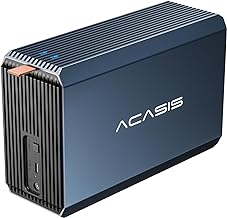5 important factors worth considering when looking for the best raid controllers
When you’re looking to upgrade or set up a strong data storage system, raid controllers play a crucial role. These devices are essential for protecting and managing data in a world where information is extremely important. As technology advances quickly, choosing the right raid controller can be complicated, so it’s important to understand the key factors that make them effective. factors such as performance, compatibility, and data redundancy all play a big part in how well your storage system works. To navigate this process successfully, you need to pay close attention to details and look beyond just the technical specs. This will help you create a top-notch storage system instead of a mediocre one.
See our guide to the best raid controllers.
Number of supported drives
When you buy a RAID controller, the number of drives it can handle is important for how well your storage system will work. Choosing a RAID controller that can handle more drives not only gives you more storage space, but also helps keep your data safe and makes it easier to access. A controller with support for many drives lets you expand your storage without needing more hardware, making it easier and more cost-effective to adapt to changing storage needs.
Having a RAID controller that can handle more drives allows you to create strong and reliable storage setups that can keep working even if a drive fails. Supporting more drives also helps your system run better by spreading out the workload across more storage devices, leading to improved performance and easier access to data. So, it’s important to choose a RAID controller that can handle a lot of drives, not just for now but also to make sure your storage system can grow and keep working well in the future.
RAID levels supported
When choosing a RAID controller, the types of RAID levels it supports are important for how well your storage system will perform and protect data. Picking a controller that can handle various RAID levels like RAID 0, RAID 1, RAID 5, and RAID 10 gives you flexibility and data security. Each RAID level has its own benefits, whether it’s about speed, redundancy, or a mix of both. By selecting a controller that supports multiple RAID levels, you can set up your storage system to meet your specific needs, ensuring efficient data management and protection.
Being able to switch between different RAID levels as your storage needs change over time allows for growth and flexibility. Choosing a RAID controller that supports different RAID levels helps make sure your storage is ready for the future and allows you to optimize performance and data protection based on what you need now. Picking a controller with a wide range of RAID level support lets you create a storage setup that balances speed, fault tolerance, and capacity, making your data storage more efficient and reliable.
Data transfer rates
When it comes to buying RAID controllers, it’s important to understand data transfer rates. Choosing a controller with high data transfer rates can greatly improve how your system performs and how efficient it is. A fast data transfer rate not only speeds up how data is processed and retrieved, but it also makes operations run more smoothly and reduces delays. Getting a RAID controller with impressive transfer rates isn’t just a nice thing to have; it’s a smart way to manage data in your system. By focusing on controllers that offer fast transfer speeds, users can easily handle large amounts of data, complete tasks quickly, and stay productive.
A RAID controller with excellent data transfer rates can make a big difference for businesses and individuals. It not only speeds up data-heavy operations but also creates a better user experience by reducing delays and downtime. In a digital world where time is important, having a controller that can quickly move data between drives can be a game-changer. With faster transfer rates, tasks that used to be difficult can now be done efficiently, allowing users to focus on other important parts of their work. Ultimately, choosing a RAID controller with superior data transfer rates isn’t just about speed; it’s about giving users the tools they need to manage data easily.
Cache memory size
When choosing a RAID controller, it’s important to think about the size of the cache memory. The cache memory helps improve the performance and data integrity of the RAID system. A bigger cache memory allows for faster access to commonly used data, which reduces delays and makes the system more responsive. This is especially important in places where fast data processing is needed. Selecting a RAID controller with a large cache memory can make data storage smoother and more efficient, which is a good investment for businesses or individuals focusing on performance and reliability.
In addition, a larger cache memory can also help protect data better and speed up the process of rebuilding data if a drive fails. The cache memory serves as a temporary storage space for data before it’s saved to the main storage disks, providing an extra layer of protection against data loss. In situations where data redundancy and fault tolerance are crucial, like in servers or data centers, a RAID controller with a big cache memory can offer peace of mind and make sure important data stays safe and accessible. Therefore, when looking at RAID controllers, giving careful thought to the cache memory size can greatly impact how efficient and reliable your storage setup is, underscoring its importance in maximizing performance and reliability in your data storage solution.
Compatibility with operating system and hardware
When looking to buy a RAID controller, it’s important to make sure it works with both your operating system and hardware. Not doing this can cause problems with compatibility, slow performance, and system crashes. To avoid these issues, it’s crucial to research and choose a RAID controller that matches your system setup.
Selecting a RAID controller that works well with your operating system and hardware not only improves performance but also makes your RAID setup more efficient. Taking the time to check compatibility at the beginning will make your experience easier and help you get the most out of your storage solution. A RAID controller that works seamlessly with your system will offer reliable data protection and optimal performance, making it a valuable investment for storage enthusiasts and professional users alike.
Conclusion
In today’s digital world, where storing and accessing data is crucial, RAID controllers play a vital role in optimizing system performance and protecting data. By using RAID technology, users can improve data protection, read/write speeds, and scalability. As technology advances, RAID controllers provide stability in a data-heavy world, offering a secure way to safeguard information and improve efficiency. They are not just technically important but also provide peace of mind for users managing data. In the end, RAID controllers go beyond just hardware, showing a commitment to innovation and reliability in the digital world.



